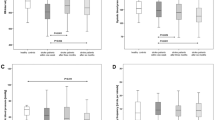Abstract
The effects of left- and right-sided hemispheric brain infarction on variability in circadian blood pressure and cardiovascular measures were investigated in 35 patients to test for asymmetry of the sympathetic consequences of stroke. No significant differences regarding age, size of infarction or extent and frequency of damage to the insular cortex could be detected between the two groups. Patients with right-sided infarction showed a significantly reduced circadian blood pressure variability [diastolic: -1% (95% CI -4 to 1) vs -6% (-9 to -2);P < 0.05] and a higher frequency of nocturnal blood pressure increase (47% vs 35%;P < 0.05) as compared with patients with left-sided infarction. Right-sided infarction was also associated with higher serum noradrenaline concentrations [546 pg/ml (95% CI 415–677) vs 405 pg/ml (266–544);P < 0.05], and ECG more frequently showed QT prolongation (53% vs 35%;P < 0.05) and cardiac arrhythmias (67% vs 20%;P < 0.005). However, irrespective of the hemisphere damaged, patients with insular infarction showed the most pronounced changes of these parameters. In addition, two patients with right-sided strokes (13%) involving the insula, but none with a left-sided infarction, developed myocardial infarction. These findings suggest lateralization of sympathetic activation with right-sided dominance for sympathetic effects following hemispheric stroke.
Similar content being viewed by others
References
Allen GV, DiCarlo MA, Cechetto DF (1992) Changes in the neurochemical organization of forebrain autonomic sites following focal cerebral ischemia. Neurosci Abstr 18: 1173
Ashman R, Hull E (1945) Essentials of electrocardiography. Macmillan, New York
Baumgart P, Walger P, Dorst KG, Eiff M von, Rahn KH, Vetter H (1989) Can secondary hypertension be identified by twenty-four-hour ambulatory pressure monitoring? J Hypertens 7 [Suppl 3]: S25-S28
Bravo EL, Tarazi RC, Gifford RW, Stewart BH (1979) Circulating and urinary catecholamines in pheochromocytoma. N Engl J Med 301: 682–686
Campbell MJ, Gardner MJ (1989) Calculating confidence intervals for some non-parametric analysis. In: Gardner MJ, Altmann DG (ed) Statistics with confidence. BMA, London, pp 71–79
Cechetto DF, Wilson JX, Smith KE, Wolski D, Silver MD, Hachinski VC (1989) Autonomic and myocardial changes in middle cerebral artery occlusion: stroke modells in the rat. Brain Res 502:296–305
Goldstein DS (1979) The electrocardiogram in stroke: relationship to pathophysiological type and comparison with prior tracings. Stroke 10: 253–259
Graettinger WF, Lipson JL, Cheung DG, Weber MA (1988) Validation of portable noninvasive blood pressure monitoring devices: comparisons with intra-arterial and sphygmomanometer measurements. Am Heart J 116: 1155–1160
Hachinski HC, Oppenheimer SM, Wilson JX, Guiraudon C, Cechetto DF (1992) Asymmetry of sympathetic consequences of experimental stroke. Arch Neurol 49: 697–702
Lindenstrom E, Boysen G, Christiansen LW, Hansen BR, Nielsen PWC (1991) Reliability of Scandinavian Neurological Stroke Scale. Cerebrovasc Dis 1: 103–107
Meyer JS, Stoica E, Pascu I, Shimazu K, Hartmann A (1973) Catecholamine concentrations in CSF and plasma of patients with cerebral infarction and haemorrhage. Brain 96: 277–288
Middeke M, Klüglich M, Holzgreve H (1991) Circadian blood pressure rhythm in primary and secondary hypertension. Chronobiol Int 8: 451–459
Myers MG, Norris JW, Hachinski VC, Sole MJ (1981) Plasma norepinephrine in stroke. Stroke 12: 200–204
Norris JW, Froggatt GM, Hachinski VC (1978) Cardiac arrhythmias in acute stroke. Stroke 9: 392–396
Oke A, Keller R, Meford I, Adams RN (1978) Lateralization of norepinephrine in human thalamus. Science 200: 1411–1413
Oppenheimer SM (1991) The insular cortex and the control of cardiac rythm. Thesis, University of Oxford
Oppenheimer SM, Cechetto DF, Hachinski VC (1990) Cerebrogenic cardiac arrhythmias. Cerebral electrocardiographic influences and their role in sudden death. Arch Neurol 47: 513–519
Oppenheimer SM, Wilson JX, Guiraudon C, Cechetto DF (1991) Insular cortex stimulation produces lethal cardiac arrhythmias: a mechanism of sudden death? Brain Res 550:115–121
Oppenheimer SM, Gelb A, Girvin JP, Hachinski VC (1992) Cardiovascular effects of human insular cortex stimulation. Neurology 42: 1727–1732
Ringelstein EB, Koschorke S, Holling A, Thron A, Lambertz H, Minale C (1989) Computed tomographic patterns of proven embolic brain infarctions. Ann Neurol 26: 759–765
Robinson RG (1979) Differential behavioral and biochemical effects of right and left hemispheric cerebral infarction in the rat. Science 205: 707–710
Sander D, Klingelhafer J (1992) Prognostic and therapeutic relevance of circadian blood pressure variations after cerebral infarction. J Neurol 239 [Suppl 3]: 77
Sander D, Klingelhafer J (1994) Changes of circadian blood pressure patterns after hemodynamic and thromboembolic brain infarction. Stroke 25: 1730–1737
Silver FL, Norris JW, Lewis AJ, Hachinski VC (1984) Early mortality following stroke: a prospective review. Stroke 15: 492–496
Smith KE, Hachinski VC, Gibson CJ, Ciriello J (1986) Changes in plasma catecholamine levels after insula damage in experimental stroke. Brain Res 375:182–185
Talairach J, Tournoux P (1988) Coplanar stereotaxic atlas of the human brain. Thieme, Stuttgart
Tuck ML, Stern N, Sowers J (1985) Enhanced 24-hour norepinephrine and renin secretion in young patients with essential hypertension: relation with the circadian pattern of arterial blood pressure. Am J Cardiol 55: 112–115
Turton MB, Deegan T (1974) Circadian variations of plasma catecholamine, cortisol and immunoreactive insulin concentrations in supine subjects. Clin Chim Acta 55: 389–397
Zamrini EY, Meador KJ, Loring DW, Nichols FT, Lee GP, Figueroa RE, Thompson WO (1990) Unilateral cerebral inactivation produces differential left/right heart rate responses. Neurology 40:1408–1411
Author information
Authors and Affiliations
Additional information
Supported by the Friedrich-Schiedel-Stiftung
Rights and permissions
About this article
Cite this article
Sander, D., Klingelhöfer, J. Changes of circadian blood pressure patterns and cardiovascular parameters indicate lateralization of sympathetic activation following hemispheric brain infarction. J Neurol 242, 313–318 (1995). https://doi.org/10.1007/BF00878874
Received:
Revised:
Accepted:
Issue Date:
DOI: https://doi.org/10.1007/BF00878874




